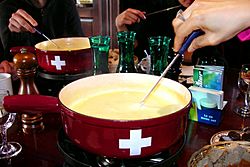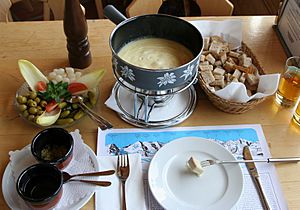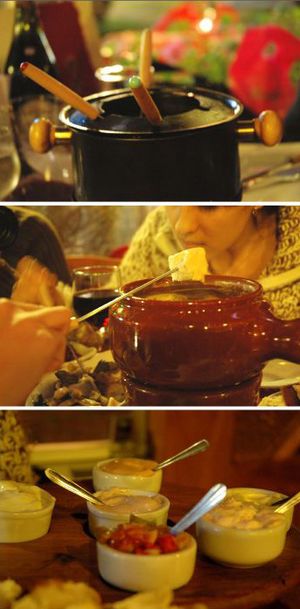Fondue facts for kids

Dipping a cheese fondue with a long-stemmed fork
|
|
| Place of origin | France, Italy, and Switzerland |
|---|---|
| Main ingredients | Cheeses, white wine, seasoning, garlic, often kirsch |
Fondue is a fun and tasty meal where you dip pieces of food into a hot, melted sauce. It started as a dish where people dipped bread, potatoes, or vegetables into hot, melted cheese. This type of fondue is very popular in countries like Switzerland, Piedmont (in Italy), and Savoie (in France).
Over time, the idea of fondue grew to include other types. For example, in Fondue Bourguignonne, you dip pieces of meat (usually beef) into hot oil. Fondue Chinoise uses thin slices of meat that are cooked in a hot broth. Both meat fondues are served with different sauces for dipping. The classic cheese fondue uses a mix of cheese, white wine, and a little bit of starch to make it smooth and creamy.
Contents
What is the history of fondue?
Many people think fondue is a very old way for country people to use hard cheese and stale bread. Both Swiss and French people have been making fondue for a long time. It probably first came from the Jura Mountains, which are between France and Switzerland.
The oldest clear recipes for fondue used eggs and came from Vaud, a region in Switzerland, in the early 19th century. Many Swiss towns and areas later created their own special fondue recipes. These recipes used local cheeses, wines, and other ingredients.
Fondue became very popular in the United States during the late 1960s and early 1970s.
How do you prepare fondue?
To make a classic cheese fondue, you need bread and cheese. People also often have small side plates with garlic, pickled cucumbers, onions, and olives.
First, you rub the inside of a special pot, called a caquelon, with a cut piece of garlic. Then, you add wine and cheese to the pot. You heat and stir them until they are warm and melted into a smooth liquid. A small amount of starch is added to help the ingredients mix well. Just before serving, some strong alcohol made from cherries (called kirsch) is often added for extra flavor.
A common recipe uses about 1 decilitre (a small amount) of dry white wine and 200 grams of cheese for each person. The cheese is usually a mix of hard cheese, like Gruyère, and a semi-hard cheese, like Emmental cheese.
What is La Religieuse?
A cheese fondue should be kept warm enough to stay smooth and liquid. But it should not be so hot that it burns.
If the temperature is just right, a thin, crispy layer of toasted cheese will form at the bottom of the caquelon. This crispy layer is called la religieuse, which means "the nun" in French. It feels like a thin cracker. People carefully lift it out and share it. In Switzerland, kids sometimes even argue over who gets this delicious crispy bit!
What are other types of fondue?
Fondue Bourguignonne is named after Burgundy, a region in France. For this fondue, you use a pot of hot oil for cooking. Small pieces of meat are dipped into the hot oil to cook them quickly. Many different sauces are served on the side for dipping the cooked meat. This type of fondue first appeared in the 1950s.
Fondue Chinoise uses a pot of hot liquid, usually a thin meat soup or broth, for cooking. Thin slices of meat (often beef) are dipped into the very warm broth to cook them. Like Fondue Bourguignonne, various sauces are served on the side. At the end of the meal, the flavorful broth from the pot is often drunk as a thick soup.
Chocolate Fondue was first made in the 1960s. For this sweet treat, slices of fruit or pieces of cake are dipped into a pot of warm, melted chocolate.
What are the fondue rules?
When eating fondue, it's polite not to touch the dipping fork with your tongue. This is because the same fork goes back into the shared pot. For meat fondues, it's common to use a second fork to take the cooked meat off the dipping fork before eating it.
In Switzerland, there are some old traditions. If a man accidentally drops his piece of bread in the cheese pot, he traditionally buys a bottle of wine for the group. If a woman drops her bread, she gives a kiss to the man on her left!
Images for kids
See also
 In Spanish: Fondue para niños
In Spanish: Fondue para niños






